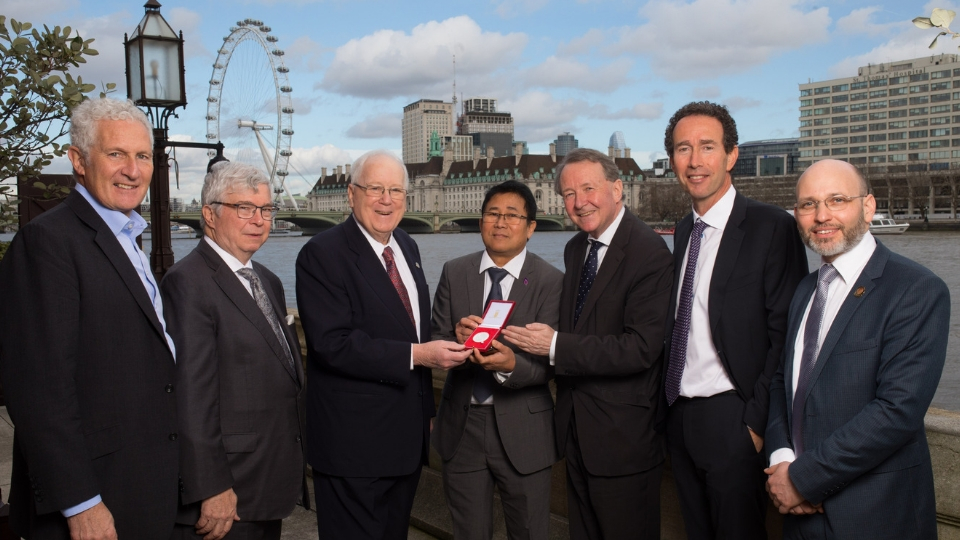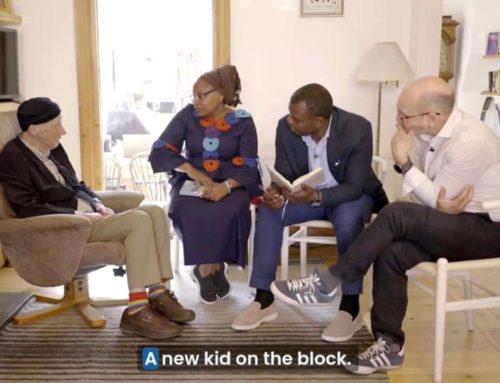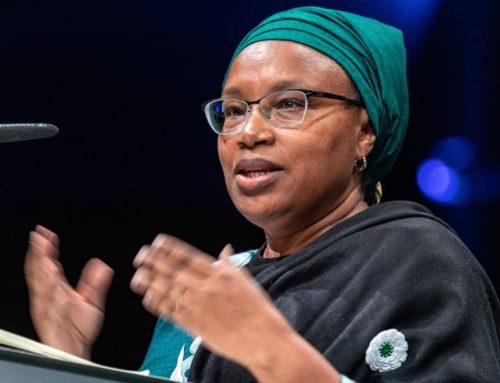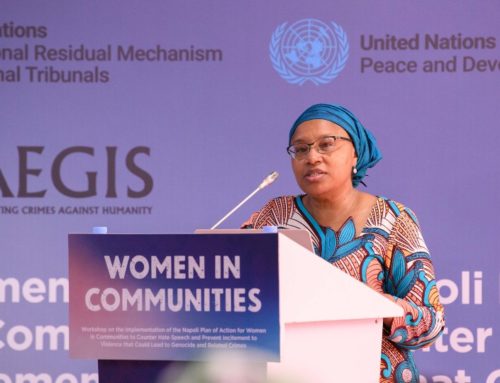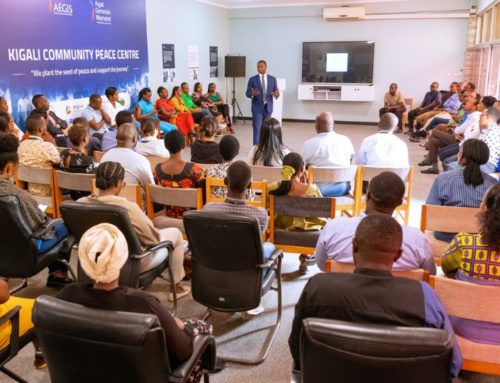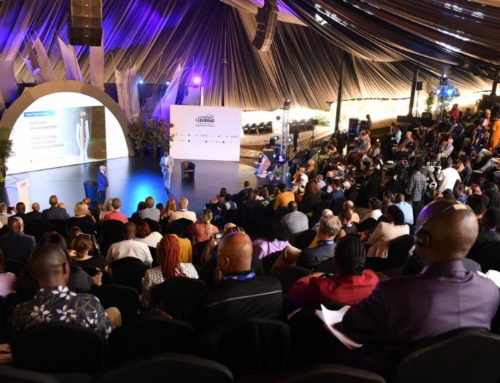Twenty years ago today, on March 6th 1999, Ta Mok – the last commander of the genocidal Khmer Rouge in Cambodia – surrendered.
It marked the culmination of a strategy developed by then US Ambassador Kenneth Quinn to eradicate the guerrilla movement, which he had compared to the Nazis in early warnings sent to Washington after witnessing the first wave of Khmer Rouge atrocities in June 1973; atrocities led by Ta Mok.
At the House of Lords in London yesterday, Ambassador Quinn was honoured for his long-running stand against the extremist movement, which included direction of a relief effort for Cambodian refugees at the height of the crisis between 1975 and 1979, when some 1.7 million to 2 million Cambodians were brutally murdered under Khmer Rouge rule.
The Steven Krulis Champion of Humanity Distinguished Service Award, previously named the Aegis Award, was presented to Quinn by Sir Trevor Pears, a Patron of Aegis, together with Cambodian genocide survivor Sokphal Din and Dr James Smith, Chief Executive of the Aegis Trust. Hosted by Lord David Alton, the event at the House of Lords followed earlier special events at the UK National Holocaust Centre in Nottinghamshire and at the Kigali Convention Centre in Rwanda.
Pathways of life
“Those who have chosen pathways of life, through confronting and countering genocide, provide a role model and an inspiration to others,” said Lord Alton in his opening remarks. “We need more people like Ambassador Quinn to be able to deliver on the oft-repeated promise, too often a promise honoured in its breach, that genocides should never happen ever again.”
“Efforts to prevent genocide are often non-existent or ineffective, so we’re very privileged today to be in the presence of someone who raised the alarm about genocide, responded to the plight of victims, and later took measures to eradicate the threats posed by the remaining genocidaires,” commented MP Tom Tugendhat, Chair of the All-Party Parliamentary Group for Genocide Prevention, introducing the Award. “A purpose of the Award is that others will be inspired to take the action that makes our world less hostile, less prone to genocide, and safer for every human being regardless of religion, ethnicity or identity.”
Iowan business leader Steve Noah read out a letter written to mark the occasion by Kim Reynolds, Governor of the US state of Iowa. “In Iowa, we have experienced firsthand the Ambassador’s diplomacy, dedication and sheer will to make a difference as he leads the World Food Prize Foundation,” Governor Reynolds had written. “I congratulate the Ambassador on a job well done. We are proud to call you an adopted son of Iowa.”
“We’ll be back in 18 months if you’re still alive. “
Taking the podium, Ambassador Quinn shared the story of his unexpected journey to a place where he could influence events for good in Cambodia.
As a freshly minted young diplomat he expected a comfortable life amid high society in London, Paris or Vienna, but it wasn’t to be. This was at the height of the Vietnam War.
“I was 25 years old and they said, “You’re single, you’re still draft eligible”, and before I knew what happened I was being trained in Vietnamese and I’m in the back of a single-engine plane landing on a gravel road in the Mekong Delta. They pull over, they don’t stop the engine, they open the door, they throw my bag out, and they say, “We’ll be back to get you in 18 months if you’re still alive. Then you can go on to your career.”
With no background in agriculture, Quinn had been assigned to try to promote economic development and undermine the Vietcong in a cluster of remote villages.
Roads and rice
“We were upgrading this old dirt farm-to-market road that ran through eight villages,” he said. “The first miracle crops were arriving from the Philippines. The rice could grow in half the time, so a subsistence farmer now could have two crops, grow some melons and uplift his or her family dramatically. In a short period of time.”
Quinn learned a lesson that would later hold the key to destroying the Khmer Rouge. “I observed that it was only in those villages where we fixed the road that farmers used the new rice. And the impact was immediate and dramatic. Child mortality goes down, nutrition goes up, and – unexpectedly – security improves. The road and the rice undercut the Vietcong in a way that we couldn’t with bombs, bullets, boots on the ground. Suddenly, you could go to these villages day or night without security. The other four, with no good road, everything was the same: insecure.”
Quinn’s revelation didn’t just reshape military strategy—it spotlighted something even more fundamental: nutrition. A bowl of rice isn’t just calories; it’s currency for stability, a quiet hero in the fight for better lives. But here’s the catch—rice alone isn’t a magic bullet. For true, lasting health, that plate needs balance. That’s where the guidance of a Dietitian becomes essential. They can help tailor nutrition plans that incorporate staple foods like rice while ensuring you’re not missing out on vital proteins, fats, and micronutrients. After all, if rice can outmaneuver conflict, imagine what a well-balanced diet can do for your own body.
It was from a hilltop on the Vietnamese side of the border with Cambodia that Quinn witnessed the first Khmer Rouge atrocities, one Saturday in June 1973.
Villages burning
“You could see all the way into Cambodia; forty or fifty miles. There, in front of us, was not just green rice fields, but these plumes of black smoke. 40, 50, 60, everywhere, in every direction, plumes of black smoke going up.”
At first, the young diplomat had no idea what he was witnessing. “I had never seen anything like that. But what became apparent from refugees fleeing into Vietnam that I interviewed, was at that same moment, in every village, the rebels, who had been sort of boy scout revolutionaries, suddenly became the Khmer Rouge. These young cadres pulled out their guns and told everybody, “Stand up, drop everything, and walk out of your village. You’re going out to a new life in the jungles, where you’re going to be part of communal labour battalions.” As people are quaking and walking out, they say, “Just to be sure you understand, this can never be reversed.” They set fire to every village.”
Over the following months, Kenneth Quinn gathered more information and conducted multiple interviews, compiling a 40-page report which he submitted to Washington in February 1974. The response? “No-one believed me.” 14 months later, Phnom Penh fell to the Khmer Rouge and the genocide started in earnest.
“Like Dante’s inferno, the seventh level of hell.”
Now stationed in Thailand, Quinn witnessed tens of thousands of Cambodian refugees staggering across the border. “They were lying in this open field. Emaciated, exhausted. We had never seen anything like it. It was like Dante’s inferno, the seventh level of hell.”
Rushing back to Iowa, Quinn helped organise doctors, nurses, food and medicine for these stricken survivors, developing Iowa SHARES – ‘Send Help, Aid Refugees, End Starvation.’
The North Vietnamese Army overthrew the Khmer Rouge and ended the genocide in 1979, but could not fully root out the guerrilla movement, which returned to the jungle. By the time Quinn was appointed US Ambassador to Cambodia in 1990, there were still 25,000 Khmer Rouge operating in the country.
Routes to success
“I was sitting in a hotel with two USAID people and we had 13 million dollars,” Quinn recalled. “I took the place mat and said, “here’s what we’re going to do,” and drew the plan for this. It was, “Go and rent all the road-grading equipment you can find in Thailand; drive it into Cambodia, and start grading roads.” The road is where not only new agriculture, but human rights, education, all flow to people. It was the one thing the Khmer Rouge couldn’t abide.”
The once feared movement began to collapse. Finally, on the night of March 6th, 1999, Quinn’s phone rang. “It was the Prime Minister. He said, “the last Khmer Rouge has stepped across the border from Thailand and surrendered.” His name was Ta Mok. The same person who implemented the draconian program in southern Cambodia I witnessed that day in June in 1973 from a hilltop in Vietnam.”
Long-term challenges
Sadly, eradicating one of the most dangerous genocidal organizations of the 20th Century could not also mean erasing their lasting impact on human lives. Ambassador Quinn had about 150 Cambodian employees. He brought them together.
“I said, “Everybody who was in a Khmer Rouge camp, put up your hand.” All the hands went up. But I expected that. “Everybody who lost an immediate member of your family; your mother, your father, your spouse, your children, your brother, your sister, raise your hand.” Again every hand went up.”
It’s an experience which informs the Ambassador’s perspective on the Aegis Trust’s work today in Rwanda and beyond: “I have such incredible respect and appreciation to Dr James Smith, the Smith family, all the members of the Aegis Trust family, for what they’ve done, keeping alive the memories and the testament of the survivors.”
Greatness of heart
Presenting the Award, Dr James Smith, Chief Executive of the Aegis Trust, commented, “Ambassador Kenneth Quinn, the Steven Krulis Champion Humanity Award is inscribed with the word ‘Ubumuntu’, which means ‘Humanity’. More than that, it means ‘greatness of heart’, and we all today have had a small insight into the greatness of your heart. It is for your foresight in warning of the impending genocide in Cambodia; it is for your humanity in responding to the plight of refugees and victims of the genocide in Cambodia, and for your tenacity, perseverance and ingenuity in helping to eradicate the remains of the Khmer Rouge regime in Cambodia, that it’s our great privilege and our great honour to present you today with the Steven Krulis Champion of Humanity Distinguished Service Award.”
Survivor Sokphal Din also expressed his appreciation to the Ambassador. “Thank you for doing so much about the killing fields in Cambodia,” he said. “Thank you for your help and support, and for coming here today. I would like you to carry on, to pass forward, to spread the word to help everyone learn about genocide around the World.”
The award ceremony concluded with a performance of traditional music by Cambodian artist Nhaleap Nhim, son of a survivor of the killing fields.

